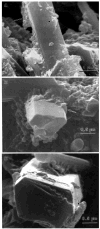Degradation, fatigue, and failure of resin dental composite materials
- PMID: 18650540
- PMCID: PMC2561305
- DOI: 10.1177/154405910808700802
Degradation, fatigue, and failure of resin dental composite materials
Abstract
The intent of this article is to review the numerous factors that affect the mechanical properties of particle- or fiber-filler-containing indirect dental resin composite materials. The focus will be on the effects of degradation due to aging in different media, mainly water and water and ethanol, cyclic loading, and mixed-mode loading on flexure strength and fracture toughness. Several selected papers will be examined in detail with respect to mixed and cyclic loading, and 3D tomography with multi-axial compression specimens. The main cause of failure, for most dental resin composites, is the breakdown of the resin matrix and/or the interface between the filler and the resin matrix. In clinical studies, it appears that failure in the first 5 years is a restoration issue (technique or material selection); after that time period, failure most often results from secondary decay.
Figures








References
-
- Al-Turki LI, Drummond JL, Agojci M, Gosz M, Tyrus JM, Lin L. Contact versus flexure fatigue of a fiber-filled composite. Dental Materials. 2007;23(5):648–653. - PubMed
-
- Annual Book of ASTM Standards, Part 10. 1990. pp. C-1161–90.
-
- ASM Handbook. Fatigue and Fracture. Vol. 19. ASM International, The Materials Information Society; 1996.
-
- Standard Test Methods for the Determination of Fracture Toughness of Advanced Ceramics at Ambient Temperature ASTM PS070–97. 1997
-
- Atkinson C, Smelser RE, Sanchez J. Combined Mode Fracture via the Cracked Brazilian Disk Test. Inter J Frac. 1982;18(4):279–291.
Publication types
MeSH terms
Substances
Grants and funding
LinkOut - more resources
Full Text Sources
Other Literature Sources
Medical

